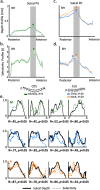Sulcal Depth in the Medial Ventral Temporal Cortex Predicts the Location of a Place-Selective Region in Macaques, Children, and Adults
- PMID: 32954410
- PMCID: PMC7727388
- DOI: 10.1093/cercor/bhaa203
Sulcal Depth in the Medial Ventral Temporal Cortex Predicts the Location of a Place-Selective Region in Macaques, Children, and Adults
Abstract
The evolution and development of anatomical-functional relationships in the cerebral cortex is of major interest in neuroscience. Here, we leveraged the fact that a functional region selective for visual scenes is located within a sulcus in the medial ventral temporal cortex (VTC) in both humans and macaques to examine the relationship between sulcal depth and place selectivity in the medial VTC across species and age groups. To do so, we acquired anatomical and functional magnetic resonance imaging scans in 9 macaques, 26 human children, and 28 human adults. Our results revealed a strong structural-functional coupling between sulcal depth and place selectivity across age groups and species in which selectivity was strongest near the deepest sulcal point (the sulcal pit). Interestingly, this coupling between sulcal depth and place selectivity strengthens from childhood to adulthood in humans. Morphological analyses suggest that the stabilization of sulcal-functional coupling in adulthood may be due to sulcal deepening and areal expansion with age as well as developmental differences in cortical curvature at the pial, but not the white matter surfaces. Our results implicate sulcal features as functional landmarks in high-level visual cortex and highlight that sulcal-functional relationships in the medial VTC are preserved between macaques and humans despite differences in cortical folding.
Keywords: functional magnetic resonance imaging (fMRI); human development; macaque; sulcal depth; sulcal pits.
© The Author(s) 2020. Published by Oxford University Press. All rights reserved. For permissions, please e-mail: journals.permissions@oup.com.
Figures





Similar articles
-
Spatial distribution and longitudinal development of deep cortical sulcal landmarks in infants.Neuroimage. 2014 Oct 15;100:206-18. doi: 10.1016/j.neuroimage.2014.06.004. Epub 2014 Jun 17. Neuroimage. 2014. PMID: 24945660 Free PMC article.
-
The relationship between cortical sulcal variability and cognitive performance in the elderly.Neuroimage. 2011 Jun 1;56(3):865-73. doi: 10.1016/j.neuroimage.2011.03.015. Epub 2011 Mar 21. Neuroimage. 2011. PMID: 21397704
-
Spatial distribution of deep sulcal landmarks and hemispherical asymmetry on the cortical surface.Cereb Cortex. 2010 Mar;20(3):602-11. doi: 10.1093/cercor/bhp127. Epub 2009 Jun 26. Cereb Cortex. 2010. PMID: 19561060
-
Automated extraction and variability analysis of sulcal neuroanatomy.IEEE Trans Med Imaging. 1999 Mar;18(3):206-17. doi: 10.1109/42.764891. IEEE Trans Med Imaging. 1999. PMID: 10363699 Review.
-
"Plis de passage" Deserve a Role in Models of the Cortical Folding Process.Brain Topogr. 2019 Nov;32(6):1035-1048. doi: 10.1007/s10548-019-00734-8. Epub 2019 Oct 3. Brain Topogr. 2019. PMID: 31583493 Free PMC article. Review.
Cited by
-
Development of Human Lateral Prefrontal Sulcal Morphology and Its Relation to Reasoning Performance.J Neurosci. 2023 Apr 5;43(14):2552-2567. doi: 10.1523/JNEUROSCI.1745-22.2023. Epub 2023 Feb 24. J Neurosci. 2023. PMID: 36828638 Free PMC article.
-
Cognitive insights from tertiary sulci in prefrontal cortex.Nat Commun. 2021 Aug 25;12(1):5122. doi: 10.1038/s41467-021-25162-w. Nat Commun. 2021. PMID: 34433806 Free PMC article.
-
A ventromedial visual cortical 'Where' stream to the human hippocampus for spatial scenes revealed with magnetoencephalography.Commun Biol. 2024 Aug 25;7(1):1047. doi: 10.1038/s42003-024-06719-z. Commun Biol. 2024. PMID: 39183244 Free PMC article.
-
Anchoring functional connectivity to individual sulcal morphology yields insights in a pediatric study of reasoning.bioRxiv [Preprint]. 2025 Jan 29:2024.04.18.590165. doi: 10.1101/2024.04.18.590165. bioRxiv. 2025. Update in: J Neurosci. 2025 Jun 25;45(26):e0726242025. doi: 10.1523/JNEUROSCI.0726-24.2025. PMID: 38659961 Free PMC article. Updated. Preprint.
-
A Theory and Model of Scene Representations With Hippocampal Spatial View Cells.Hippocampus. 2025 May;35(3):e70013. doi: 10.1002/hipo.70013. Hippocampus. 2025. PMID: 40296500 Free PMC article.
References
-
- Amiez C, Petrides M. 2014. Neuroimaging evidence of the anatomo-functional organization of the human cingulate motor areas. Cereb Cortex. 24:563–578. - PubMed
Publication types
MeSH terms
Grants and funding
LinkOut - more resources
Full Text Sources

